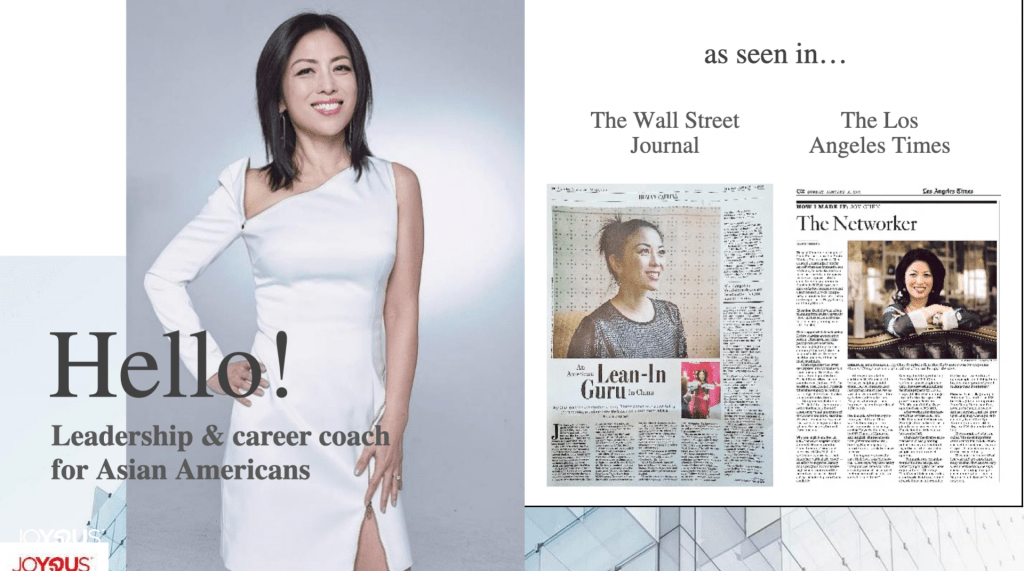Did you know that Asian Pacific Islanders are America’s most educated group — but the least likely to get promoted in the workplace?
For career coach Joy Chen, this reflects a clash of cultural leadership styles — and a call for change. APIFSA hosted a talk with Chen on Thursday, November 18, 2021, as she examined the polar opposites of Asian and Western leadership styles, and how these clashing cultural norms combined with unconscious bias to limit the careers of APIs. Most importantly, she gave her insider guidance on how to beat the odds so that we all can enjoy greater access to opportunities at all levels of American institutions and society.
Chen was raised in an immigrant family and overcame stereotypes and cultural gaps to be appointed Deputy Mayor of Los Angeles, a position she used to expand education and workforce development to underserved communities throughout Los Angeles. She also worked as an executive search consultant for Fortune 500 companies across North America, Europe and Asia.
But Chen’s journey as a career guru for the API community actually started at USC when she volunteered to advise a group of Chinese undergrads. Over the next decade, she became an in-demand speaker and career expert who The Wall Street Journal called “The American Lean-In Guru in China.”

In the summer of 2021, she returned to Los Angeles to launch JOYOUS, a career coaching and leadership development firm for APIs. Here, she answers additional questions from the APIFSA audience that followed after her presentation.
Q: To be honest, I am concerned about the speaker’s view on “playing the Western game.” This messaging seems structured for a different audience. The framework of “the West” further reinforces difference rather than sending a message that we are a part of this same fabric as well.
Joy Chen: The use of the terms “Asian style” and “Western style” and “high-power distance” and “low-power distance” comes from organizational psychology and sociology and come into business management thinking and training. They indeed are generalizations but also are based on research as well as everyday experience.
Under these frameworks, most American organizations are run in the so-called “Western style,” as 17% of all American adults were born in another country but 71% of Asian American adults were born in another country.
Q: It almost sounds like [Joy] is asking us to understand the “white people’s world” and to try assimilating ourselves to white culture as much as possible. How do you position Asians or Asian Americans in the larger U.S. society where diversity and inclusion becomes more and more important (yet challenging)?
Chen: Asian Americans are 12% of the workforce, but only 1.5% of Fortune 500 corporate officers. The vast majority of Fortune 500 corporate officers are white, born in the USA and raised in the so-called Western way. As a result, they have been trained from childhood to socialize and influence in a way that helps them succeed in Western-style, low-power-distance organizations.
Our ability to move up in these organizations depends on our ability to learn and master the unwritten rules of the game. Learning to play a game is not assimilating, it’s gaining power. We also need organizations to create access to opportunities – for that, see my LinkedIn article.

Q: Where is the emphasis on activism and pushing back against the culture that is exclusionary and toxic in the first place?
Chen: Working the inside route is not incompatible with working the outside route. Gaining power is activism. In November 2021, we elected three Asian American mayors of big cities. That is a great milestone, and [happened by] learning and mastering the political rules of the game – building coalitions, gaining endorsements, etc.
At the same time, fighting such exclusion must not be left to Asian American and other historically marginalized populations. For more on what organizations must do, see my latest LinkedIn newsletter “How racism infects who gets chosen as leaders.”
Q: I understand what Joy is saying. My parents only wanted me to study and get A’s. I wanted to have a job and wasn’t allowed because my main focus was to study. But when I got out into the real world, at one of my most important job interviews I didn’t know how to negotiate the deal and didn’t get hired.
Chen: I’m sorry to hear about your experience. Sadly, your experience is the experience of millions of Asian Americans today. I call it our “Age 30 Problem.” Asian Americans get the best grades, get into the best universities, gain the most education…but then by age 30, we plummet from being America’s highest potential group to its lowest.
For most of us Asian Americans, our parents did not climb the organizational ladder here in the USA, so they didn’t teach us the unwritten rules. Now we know, [and] we can learn and fight and be better equipped to help our own kids to break through the Asian American glass ceiling.
Q: Hi Ms. Chen, thank you for taking the time to come speak to us! I wanted to ask if there are any discrepancies within the Asian community in regards to the glass ceiling? It seems as though there are several famous Indian or Indian American CEOs, but fewer East Asian or Southeast Asian CEOs.
Chen: Indeed, there are huge discrepancies in East and South Asian rates of leadership success. The data show that South Asians (such as Indian Americans) become CEOs at a rate 6 times that of East Asians, and 3 times that of whites!
An MIT study on this point posits that the discrepancy is due to the fact that South Asians are trained up in the emotional intelligence skill of “assertiveness,” which is prized in Western management culture while East Asian cultures based on Confucianism does not train us up in assertiveness. The study is here.
